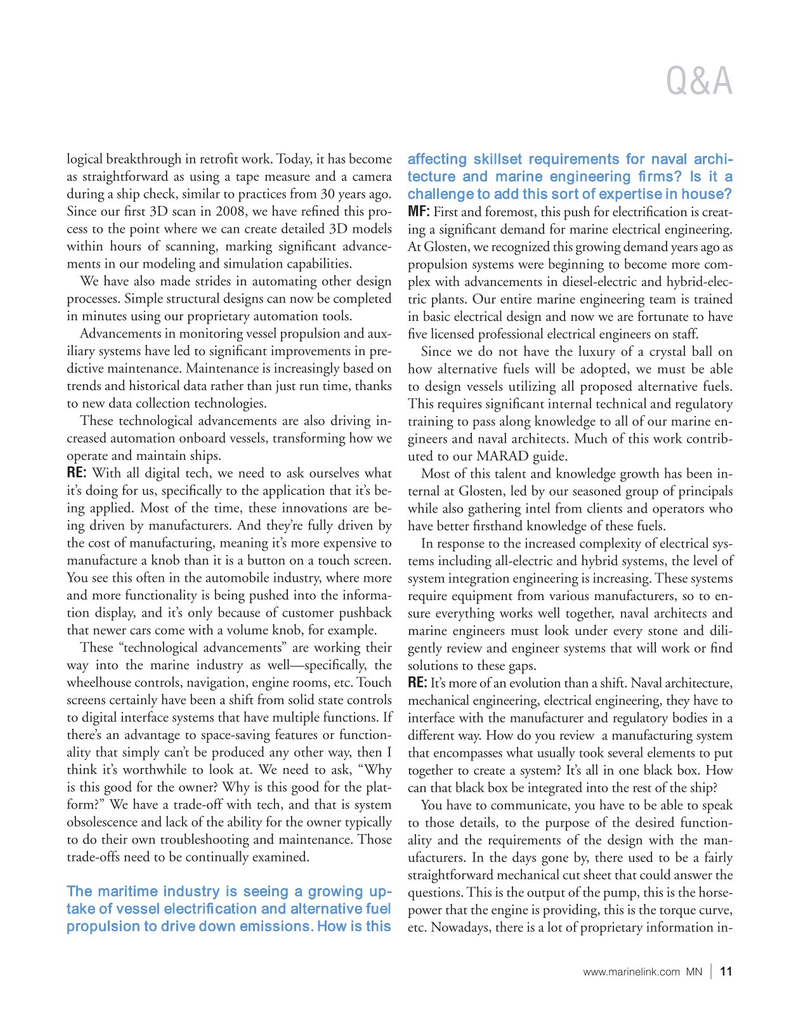
Page 11: of Marine News Magazine (August 2024)
Read this page in Pdf, Flash or Html5 edition of August 2024 Marine News Magazine
Q&A logical breakthrough in retro? t work. Today, it has become affecting skillset requirements for naval archi- as straightforward as using a tape measure and a camera tecture and marine engineering ? rms? Is it a during a ship check, similar to practices from 30 years ago. challenge to add this sort of expertise in house?
Since our ? rst 3D scan in 2008, we have re? ned this pro- MF: First and foremost, this push for electri? cation is creat- cess to the point where we can create detailed 3D models ing a signi? cant demand for marine electrical engineering. within hours of scanning, marking signi? cant advance- At Glosten, we recognized this growing demand years ago as ments in our modeling and simulation capabilities. propulsion systems were beginning to become more com-
We have also made strides in automating other design plex with advancements in diesel-electric and hybrid-elec- processes. Simple structural designs can now be completed tric plants. Our entire marine engineering team is trained in minutes using our proprietary automation tools. in basic electrical design and now we are fortunate to have
Advancements in monitoring vessel propulsion and aux- ? ve licensed professional electrical engineers on staff.
iliary systems have led to signi? cant improvements in pre- Since we do not have the luxury of a crystal ball on dictive maintenance. Maintenance is increasingly based on how alternative fuels will be adopted, we must be able trends and historical data rather than just run time, thanks to design vessels utilizing all proposed alternative fuels. to new data collection technologies. This requires signi? cant internal technical and regulatory
These technological advancements are also driving in- training to pass along knowledge to all of our marine en- creased automation onboard vessels, transforming how we gineers and naval architects. Much of this work contrib- operate and maintain ships. uted to our MARAD guide.
RE: With all digital tech, we need to ask ourselves what Most of this talent and knowledge growth has been in- it’s doing for us, speci? cally to the application that it’s be- ternal at Glosten, led by our seasoned group of principals ing applied. Most of the time, these innovations are be- while also gathering intel from clients and operators who ing driven by manufacturers. And they’re fully driven by have better ? rsthand knowledge of these fuels.
the cost of manufacturing, meaning it’s more expensive to In response to the increased complexity of electrical sys- manufacture a knob than it is a button on a touch screen. tems including all-electric and hybrid systems, the level of
You see this often in the automobile industry, where more system integration engineering is increasing. These systems and more functionality is being pushed into the informa- require equipment from various manufacturers, so to en- tion display, and it’s only because of customer pushback sure everything works well together, naval architects and that newer cars come with a volume knob, for example. marine engineers must look under every stone and dili-
These “technological advancements” are working their gently review and engineer systems that will work or ? nd way into the marine industry as well—speci? cally, the solutions to these gaps. wheelhouse controls, navigation, engine rooms, etc. Touch RE: It’s more of an evolution than a shift. Naval architecture, screens certainly have been a shift from solid state controls mechanical engineering, electrical engineering, they have to to digital interface systems that have multiple functions. If interface with the manufacturer and regulatory bodies in a there’s an advantage to space-saving features or function- different way. How do you review a manufacturing system ality that simply can’t be produced any other way, then I that encompasses what usually took several elements to put think it’s worthwhile to look at. We need to ask, “Why together to create a system? It’s all in one black box. How is this good for the owner? Why is this good for the plat- can that black box be integrated into the rest of the ship?
form?” We have a trade-off with tech, and that is system You have to communicate, you have to be able to speak obsolescence and lack of the ability for the owner typically to those details, to the purpose of the desired function- to do their own troubleshooting and maintenance. Those ality and the requirements of the design with the man- trade-offs need to be continually examined. ufacturers. In the days gone by, there used to be a fairly straightforward mechanical cut sheet that could answer the
The maritime industry is seeing a growing up- questions. This is the output of the pump, this is the horse- take of vessel electri? cation and alternative fuel power that the engine is providing, this is the torque curve, propulsion to drive down emissions. How is this etc. Nowadays, there is a lot of proprietary information in- www.marinelink.com MN 11|

 10
10

 12
12
